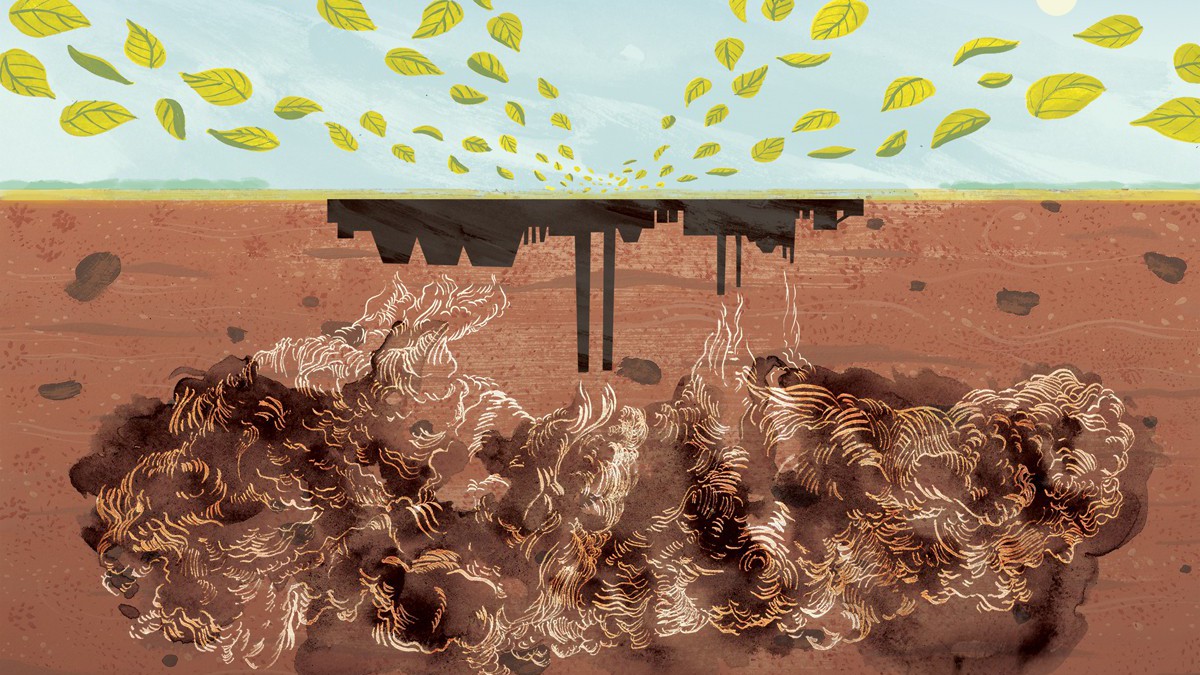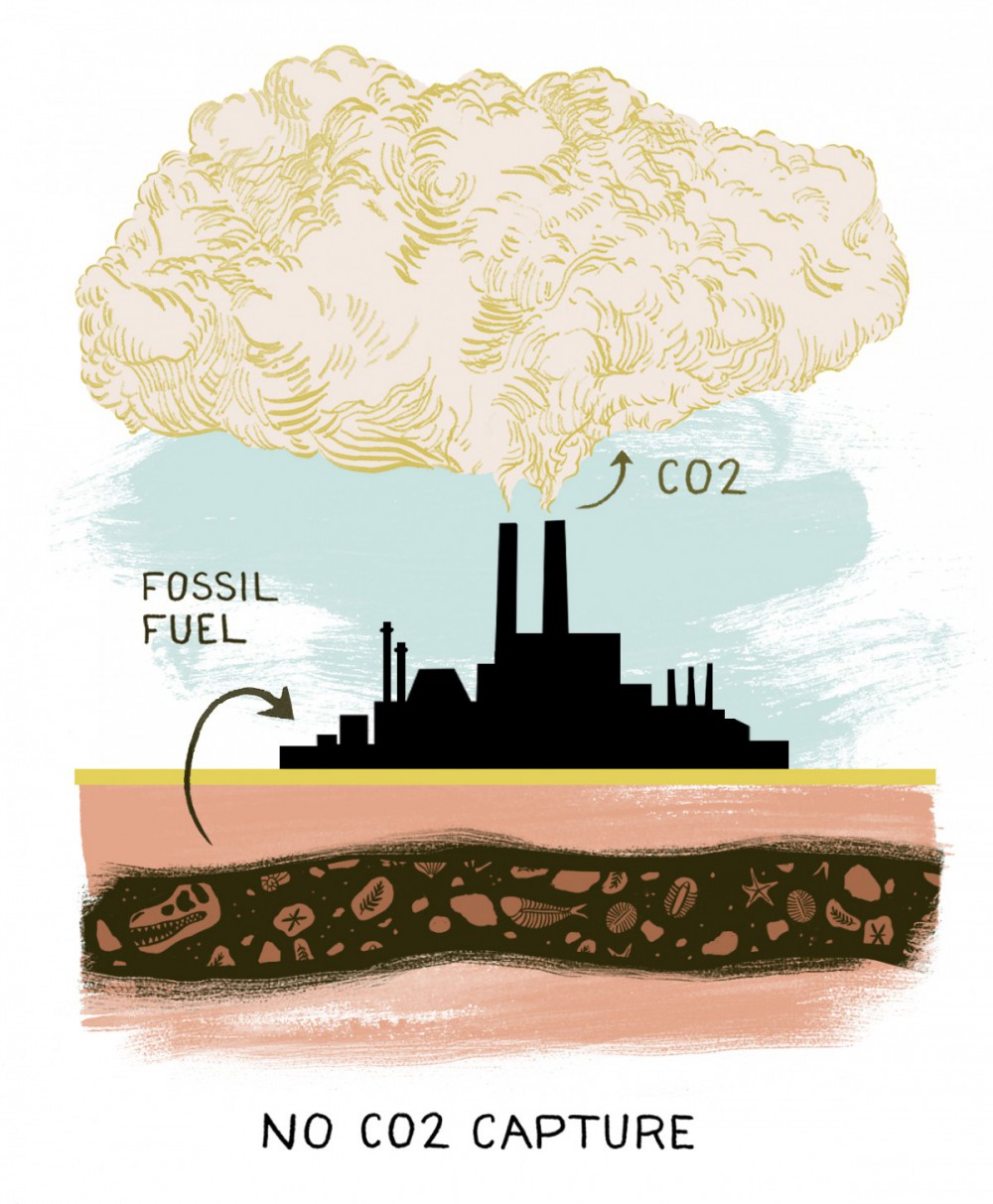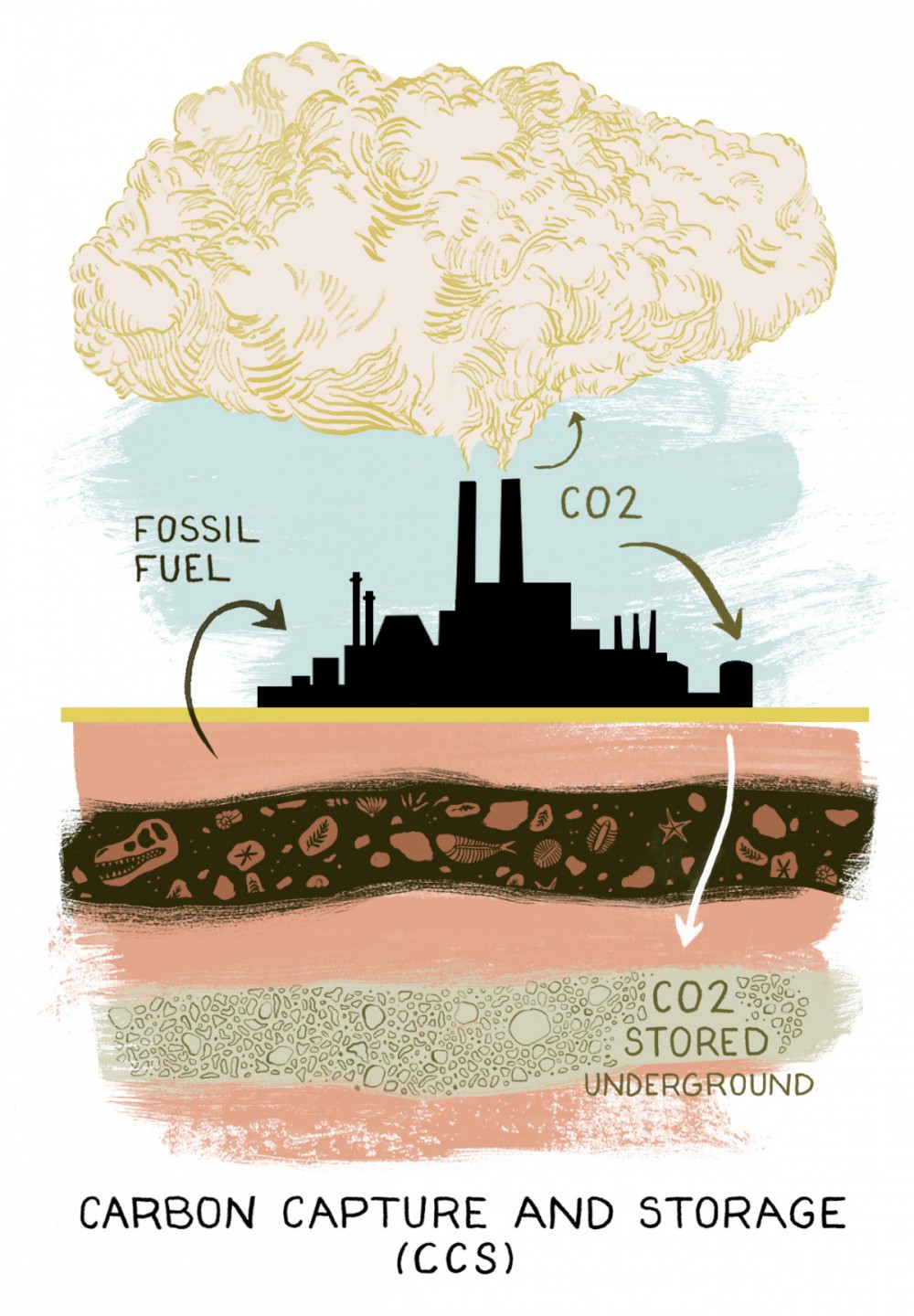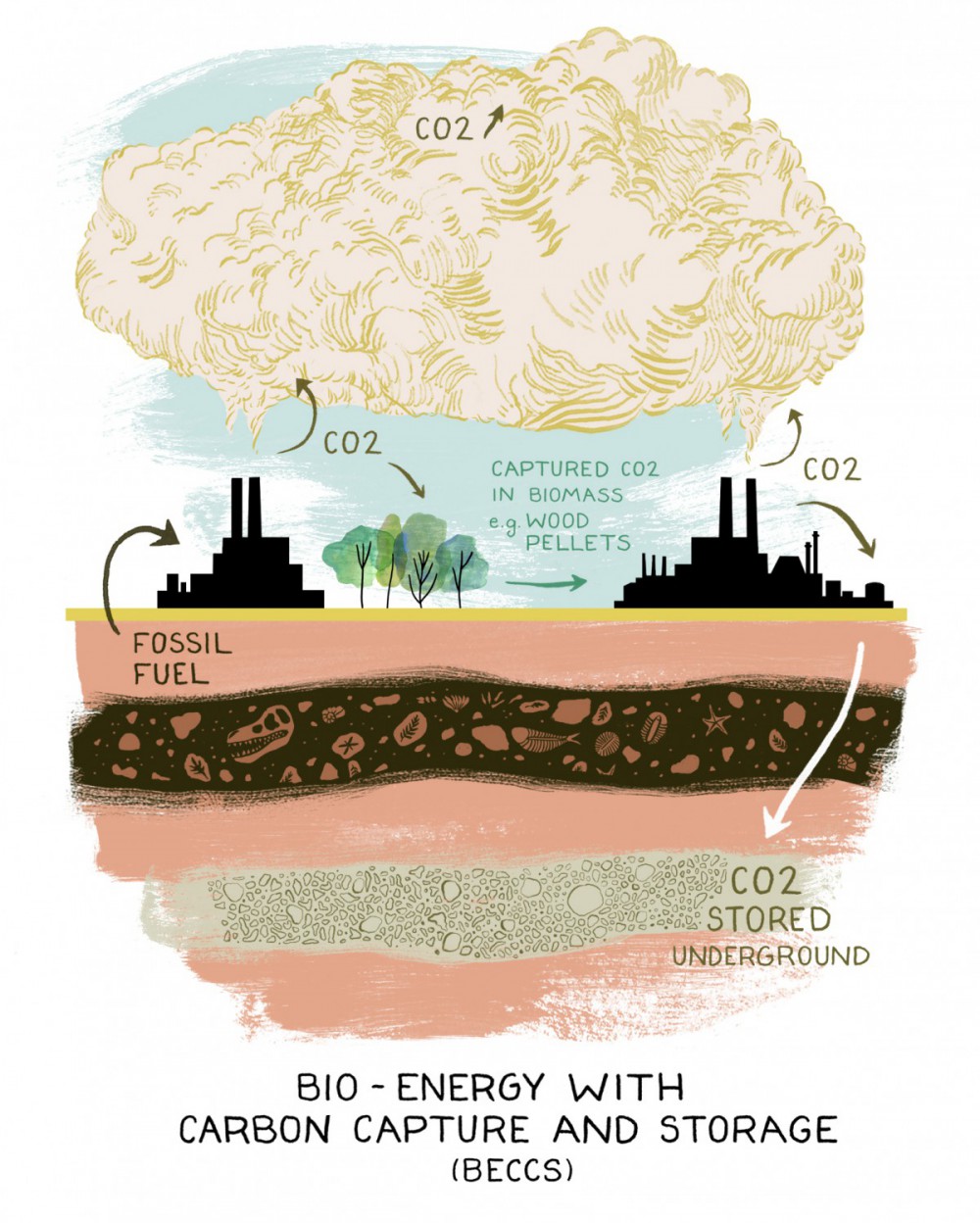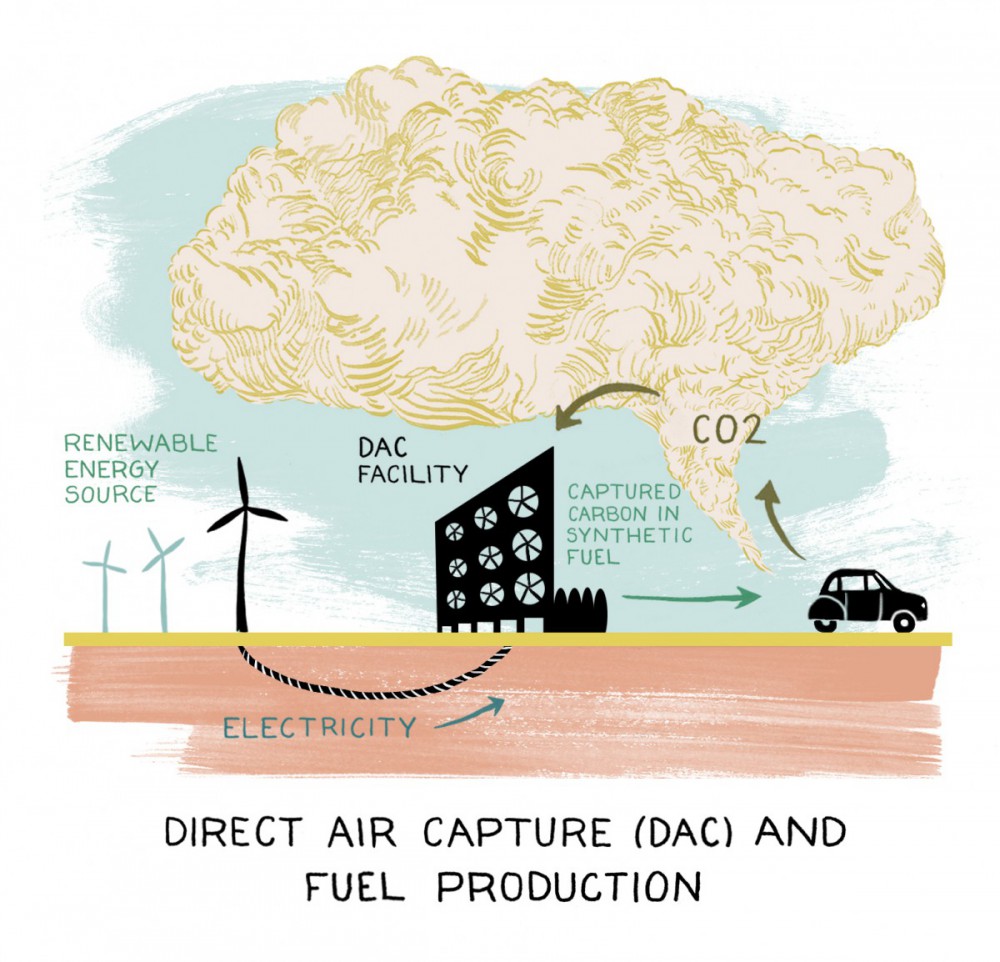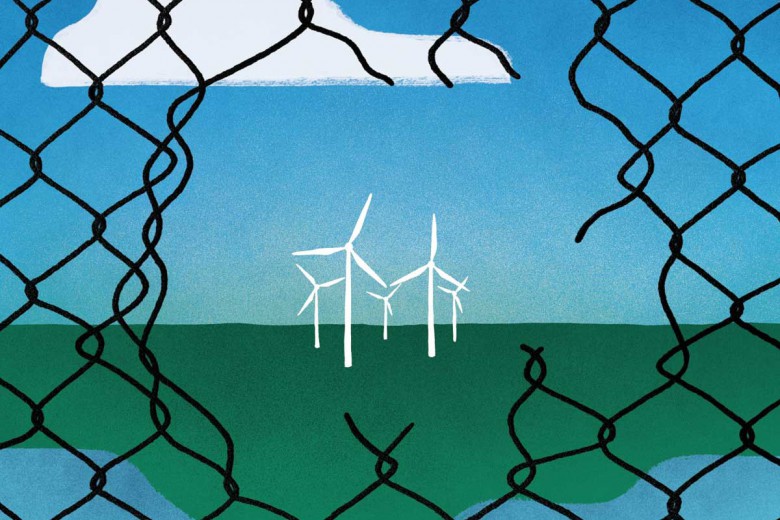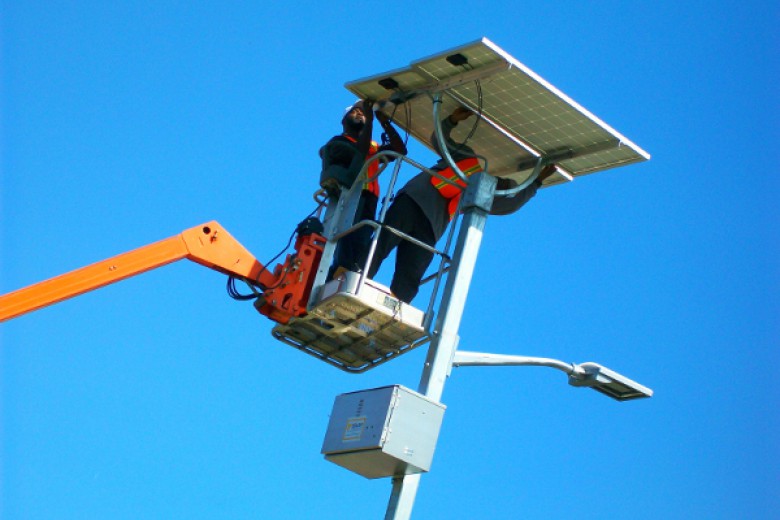On the Canadian Prairies, wheat and canola fields lie flat as quilt squares on a bed. Beneath them stretch layer after increasingly ancient layer of sediment, going down thousands of metres to porous sandstone, still holding the water of inland seas that were here before the dinosaurs. Some of these rock layers extend hundreds of kilometres across southern Saskatchewan and into Alberta, Manitoba, and the U.S.. Less porous layers block fluids from moving upward, and have kept oil and gas trapped beneath them for millions of years – until humans learned to drill well bores to get the hydrocarbons out.
Now, as we teeter on the brink of climate disaster, we’re drilling even deeper wells in a desperate attempt to put the carbon dioxide that’s warming our planet back under the ground.
Blowing smoke
This spring, the amount of carbon dioxide (CO2) in our atmosphere crashed through yet another scary round number threshold – averaging above 410 parts per million (ppm) for a full month. In the late 1800s, the level was around 290 ppm. Scientists don’t expect it to fall below 400 ppm again in our lifetimes.
Canadians have been hearing about CO2 emissions for decades, at least since Canada hosted the first international conference on global warming in Toronto in 1988. Since then, Canada and other nations have set and missed one new target after another, each time pledging even more drastic reductions than before.
Now emissions need to drop toward zero, fast. For low-lying nations already seeing the effects of sea-level rise, or tropical nations already facing heat waves pushing the limits of human physiology, it could mean their survival. In countries like Canada, emissions should drop even faster, to make room for a more gradual transition to green energy in the Global South, where energy from fossil fuels currently means both survival and growth.
But many researchers and policymakers have already given up on zero emissions as a goal for the next few decades. Instead, their plan is to drop below zero – later.
In more and more scientific models of our future, we go beyond reducing emissions to actually reversing them, creating “negative emissions” – that is, more carbon being stored than released.
Canada and other nations have set and missed one new target after another, each time pledging even more drastic reductions than before.
But these hopeful plans rely on technologies that still don’t exist – at least not beyond a few pilots and some tantalizing concepts. Compared to the way renewable energy technology has leapt forward, negative emissions technology has crawled.
The physical process used in carbon capture is actually older than the international movement to reduce emissions. As early as the 1920s, industrial facilities needed to separate CO2 out of a mixture of other gases. For instance, natural gas is mostly methane, but it can also contain some CO2 as an impurity, sometimes at high enough levels that the gas company must separate it out before they can sell the fuel.
A coal-fired generating station also produces a mixture of gases. Air used to burn the coal includes some oxygen, which combines with the carbon in the coal to produce CO2. But air is not pure oxygen, so the exhaust gases contain both CO2 and a large amount of nitrogen. A carbon-capture facility passes these mixed gases through a solvent to selectively remove the CO2, and then uses heat to drive the CO2 back out.
That step cleans the solvent for reuse, and produces relatively pure CO2 that can be stored – or sold.
In the 1970s, oil companies started pumping compressed, liquid-like CO2 down wells into oil reservoirs, where it helps dissolve more oil out of the rock pores and move it toward the producing wells. The process, called enhanced oil recovery (EOR), increases the amount of oil that can be produced before the field becomes uneconomical.
In Saskatchewan, an EOR project at the Weyburn-Midale oilfield buys most of the CO2 captured at SaskPower’s flagship carbon-capture project, Unit 3 at the Boundary Dam generating station near Estevan.
Although some CO2 flows with the oil and returns to the surface (where it is captured for reuse), some stays in the reservoir, which can be considered “carbon storage.” After the reservoir stops producing oil, it could still be used for further storage. All this assumes the CO2 will stay put – a reasonable-sounding assumption, when you consider that oil tends to move upward away from the greater pressures at greater depths, and that less-porous cap rock above the reservoir has prevented that movement for millions of years. But now numerous oil wells pierce the cap rock, creating potential pathways for leaks. Once a well is no longer useful, the oil company seals it with cement. How well the CO2 stays put depends on how well those cement seals have been made, and how closely the field will be monitored over the hundreds or thousands of years we want the stuff to stay buried.
Down a deeper well
When the oil company at Weyburn-Midale isn’t buying CO2, Boundary Dam Unit 3 comes closer to zero emissions. That’s because, instead of helping to extract more oil, the captured CO2 goes to a dedicated storage site called Aquistore.
The research project, spearheaded by the Regina-based non-profit Petroleum Technology Research Centre (PTRC), injects the unsold CO2 into the deeper Deadwood Formation, a reservoir of porous rock filled with salt water almost 3.2 km below the surface.
When I spoke to Norm Sacuta, PTRC’s communications director, he was preparing to tour a group of visitors around the facility near Estevan. He showed me a picture of the injection well: a pipe into the ground, topped with several bolt-studded fittings, looking not unlike the wellhead on a conventional oil well. Next to it, visitors see a building with meters and valves to measure and control the amount of CO2 being injected.
“Then I take them up a small rise, through the tick-infested grass, to a super-station that’s located nearby,” Sacuta says. There they see some of the monitoring equipment intended to detect potential unwanted changes around the injection site, such as uplift (from unintended pressure buildup) and earth movements (from sudden surges underground, or worse, from rock fractures).
When the oil company at Weyburn-Midale isn’t buying CO2, Boundary Dam Unit 3 comes closer to zero emissions.
At several shallow wells there, researchers can collect samples of gases and water in the ground, to test for substances they don’t want escaping from deeper layers. Visitors also get to see a geophone, part of a permanent array of detectors used to pick up seismic vibrations. Some of the vibrations are natural (such as those from distant earthquakes) and others are induced – researchers deliberately apply vibrations to the earth and record the echoes to create an image of where the CO2 has moved out from the injection well. And if pressure from the injections should happen to fracture rock layers, the geophones would “hear” it.
Sacuta says that unlike oil production, where fracturing or “fracking” subterranean rocks with high pressures can be useful to extract oil, a fracture in the sandstone layer here could actually break connections between pores in the rock, limiting the flow of CO2 into the available storage space around the well. And of course they don’t want to break the rock layer above that prevents the CO2 from leaking upward and back into the atmosphere. All the monitoring helps to verify the researchers’ prediction that the enormous Deadwood Formation can take in and hold large volumes of CO2.
If we can find a way to pull large amounts of carbon back out of the air, we will need more deep saline reservoirs like this to store it. In a 2005 report on carbon capture and storage (CCS), the Intergovernmental Panel on Climate Change (IPCC) estimated that known oil and gas reservoirs could only accept up to 900 gigatonnes of CO2, or less than half the amount of captured carbon that most scenarios assume will need to be stored. Undiscovered fields might add another 25 per cent, but the IPCC also noted that most oilfield storage capacity would not be available until after the oil is pumped out. But reservoirs like the Deadwood Formation could accommodate at least another 1,000 gigatonnes worldwide, and possibly up to 10 times that amount. And because saline reservoirs are deeper than oil reservoirs, they have fewer potential paths for CO2 to leak out. Instead, over thousands of years, it will dissolve into the salty water and begin to sink instead of pressing upward against the cap rock. Over millions of years, some of it will react chemically to become part of the surrounding rock.
Out of a wider sky
Southeast of Calgary, Alberta, where the acreages thin out into wheat fields, the Shepard Energy Centre burns natural gas to power the city. A new facility opened here in May to capture CO2 and provide it to researchers – the press release says technologies tested there could eventually capture “up to 50 per cent” of Alberta’s emissions.
If we can find a way to pull large amounts of carbon back out of the air, we will need more deep saline reservoirs like this to store it.
That number hardly seems something to celebrate, when it still means almost 130 megatonnes of CO2 from Canada’s top greenhouse gas-emitting province would go uncaptured each year. It highlights one of the most stubborn issues with carbon-capture technology to date: it tackles only the easiest part of the problem, the large point sources, leaving millions of tailpipes and small chimneys untouched, and doing nothing to capture what’s already out there warming the atmosphere and acidifying the oceans.
But there may be an even easier place to catch carbon than from coal- or gas-fired generating stations: harvesting it from plants.
Plants take in CO2, water, and photons of light to make carbohydrates – the starting point for growing everything from starchy grains to wood fibre. When such plant matter dies and decays, it releases carbon back into the atmosphere. But burning it for energy in a CCS facility would divert a stream of carbon from the natural cycle, and send it back into geologic storage.
This approach, known as bioenergy with carbon capture and storage, or BECCS, caught my attention. I could immediately picture how it would work. Relying on a natural process rather than hoping to invent a new one sounded humble – and humility is in short shrift when it comes to human-made solutions to climate change. With suitable reservoirs to store CO2, plus helpful oil-industry knowledge of things like drilling and underground imaging, Saskatchewan and Alberta are in a unique position to become part of the BECCS solution instead of leading the emissions problem.
But if plants can capture carbon, why wouldn’t we just let them store it? Leaves pull in carbon, and roots and soil microbes hold it. In Western Canada, farmers have learned to plow prairie soil less, in hopes that it will slowly regain lost carbon. There’s plenty of room here to plant trees that can live – and capture carbon – for hundreds of years.
But when plants die, carbon is released again. Planted trees can be cut down, restored grasslands can be plowed again, and incentives for soil-building farm practices can be cancelled. Climate change itself threatens to kill or weaken plants with new outbreaks of insects and disease, increased wildfires, and droughts.
Unlike forest- and soil-building projects, BECCS schemes hold out the tantalizing possibility of locking up carbon permanently. But of course, they have their own complications. Hadi Dowlatabadi, a professor at the University of British Columbia, has been studying the tangled trade-offs of social, economic, and environmental systems for decades.
“The problem is, as soon as you start using bioenergy,” Dowlatabadi tells me, “what you are actually doing is you’re capturing the photons which plants store for you from sunlight.” And that puts bioenergy crops in competition with other crops, and with non-crop plant life.
It highlights one of the most stubborn issues with carbon-capture technology to date: it tackles only the easiest part of the problem.
Warren Mabee, an energy policy researcher at Queen’s University, argues that bioenergy crops won’t take much land away from food crops because the latter command much higher market prices – although that could change if the government put a high enough tax on carbon emissions.
But before they compete with food crops, bioenergy crops may threaten natural habitats and biodiversity. Dowlatabadi says the biggest threat to biodiversity is agriculture expanding at its own margins. Palm oil can be used for biodiesel, and in Southeast Asia, plantations of oil palms have replaced mangrove swamps. With rising demand for corn ethanol to meet renewable fuel standards in the U.S., farmers have expanded corn production, often into grassland previously restored from cropland under conservation reserve programs. Mabee says we need strong, well-designed policy to make sure that BECCS projects can create new storage without displacing or destroying natural carbon storage that is already under threat.
We need strong, well-designed policy to make sure that BECCS projects can create new storage without displacing or destroying natural carbon storage that is already under threat.
Rather than picturing large land areas given over to bioenergy production, Mabee looks for any recently living material – called biomass – that can be used as fuel. In a 2014 working paper, Mabee reviewed possible sources of biomass across Canada, including not only crops for liquid fuels and tree plantations for wood pellets, but also agricultural residues like straw and seed hulls, leftover material from making wood products, and trees killed by pest outbreaks. When used at levels that protect natural cycles and future production, these sources are not enough to replace current petroleum use in transportation. But they might be enough to replace non-renewable fuels for electrical generation, Mabee tells me, providing the “dispatchable” energy generation we need to cover times when solar and wind are not available.
Then, if combined with CCS, bioenergy could convert our electrical generation from a large source of emissions (especially in Western Canada, where coal-fired energy generation is common) to a potential pathway for negative emissions.
Carbon-neutral contrails?
As I was finishing up my research for this story, still not convinced that negative emissions technologies could develop soon enough or expand fast and far enough to get us back to safety, news broke of another tool that might help us succeed.
While BECCS seized attention by proposing a Hail Mary from the plant world, some researchers kept working on the possibility of an industrial process to pull CO2 directly from the air – called direct-air capture, or DAC. In June 2018, British Columbia-based company Carbon Engineering published detailed results from a year of tests at their pilot plant in Squamish, suggesting that commercial facilities are within reach.
At the pilot plant, a large fan draws air through plastic packing material covered with a thin, flowing film of alkaline liquid. The liquid captures carbon from the air. At the commercial scale, a whole bank of these fans and “air contactors” would dominate the facility visually. The rest of the process happens in tanks and vessels, where the carbon comes out of the liquid that captured it onto pellets of calcium carbonate, and then heat drives CO2 off these pellets. The air contactors lose water through evaporation, and the heating takes energy, but otherwise the process is a closed loop with reused chemicals.
Based on their year of testing, Carbon Engineering reports that they can capture carbon at a fraction of the cost from earlier projections: between $94 and $232 per tonne, instead of $600. In an interview, chief executive officer Steve Oldham told me they would start supplying captured CO2 to projects like Aquistore “tomorrow” if governments would set a carbon price high enough.
Oldham says if we reach that point, DAC is not bad compared to other options for negative emissions. It requires only water, air, and energy – which can come from renewable sources. It functions “like a very dense forest” (in other words, it needs less land than BECCS). And it can be turned off in an instant when its work is done.
But for the near future, the company is promoting a different application. In December, using captured carbon plus hydrogen electrolysed from water, the pilot plant produced its first gasoline. That means we now have a liquid fuel that’s neither releasing fossil carbon nor competing for agricultural land, and can be used in existing vehicles. In commercial production, Carbon Engineering expects this fuel to cost less than $1.00 per litre to make. That’s still higher than conventional gasoline, but with the federal carbon tax planned to add 11.6 cents per litre at the pump by 2022, it starts to look competitive. In the future, the company expects to be able to make jet fuel, as well.
I asked Oldham whether their new gasoline would be truly carbon neutral, or whether a DAC facility, competing for limited sources of renewable energy, might indirectly keep other fossil fuel facilities operating. He told me DAC facilities could be built next to entirely new energy facilities, located where resources like sun and wind are plentiful but local demand for electricity is low. The company plans to license the process to partners worldwide, to speed its adoption.
Action now
I heard the good news about Carbon Engineering’s success from Keith Stewart, a senior energy strategist with Greenpeace. When I interviewed Tom Green, a policy analyst at the David Suzuki Foundation, he too asked if I’d seen the DAC report. It’s the kind of news environmental and political leaders need. Like the broader idea of negative emissions, the DAC story could boost public confidence that climate action could still succeed – and should still have our support.
On the other hand, no matter how promising a new technology looks, we have to continue – and intensify – existing efforts. Even Oldham says DAC technology is “part of the solution. It’s not a panacea.” DAC will need renewable energy, which is already in demand to replace fossil fuels. BECCS will need land, which must not come at the cost of biodiversity and the consent of Indigenous peoples, from whom far too much land has been stolen already. And neither DAC nor bioenergy can create substantial negative emissions without a lot more facilities to inject the captured carbon back underground.
The DAC story could boost public confidence that climate action could still succeed – and should still have our support.
Instead of waiting for a breakthrough, Green says, politicians need to remember that the sooner they act, the safer we will be. “Let’s say we go over our carbon budget, and we emit too much, and we’re above the level we should be for, let’s say 40 years.” Even if technology eventually brings levels back down, he says, “that’s not the same as never going over.” In the meantime, the excess CO2 would still be causing harm such as extreme weather and ocean acidification. And removing it later might still fail to halt runaway warming.
Green says scientific models call for negative emissions, not because they’re a sure thing, but because we’ve neglected other options. Models predict a future that assumes “ever-rising energy demand,” the authors of a recent study in Nature wrote, but we could choose a low-energy path instead, with a rapid transition to renewables, and thus dramatically reduce emissions.
In other words, we still have room to change course.
“We created these problems by going too far, too fast,” Stewart says. “The solution is not to go farther, faster.”


